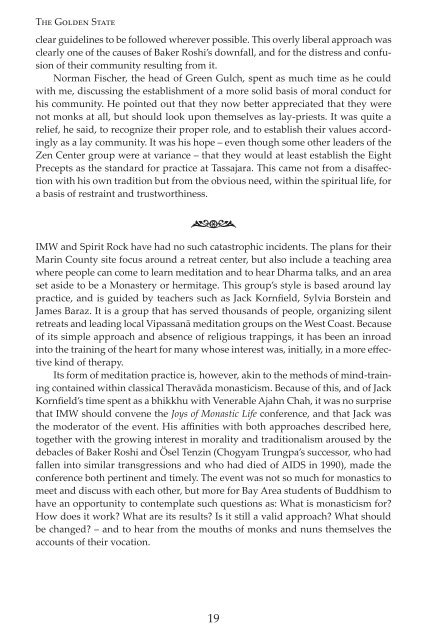Rugged Interdependency - Amaravati Buddhist Monastery
Rugged Interdependency - Amaravati Buddhist Monastery
Rugged Interdependency - Amaravati Buddhist Monastery
- No tags were found...
You also want an ePaper? Increase the reach of your titles
YUMPU automatically turns print PDFs into web optimized ePapers that Google loves.
The Golden Stateclear guidelines to be followed wherever possible. This overly liberal approach wasclearly one of the causes of Baker Roshi’s downfall, and for the distress and confusionof their community resulting from it.Norman Fischer, the head of Green Gulch, spent as much time as he couldwith me, discussing the establishment of a more solid basis of moral conduct forhis community. He pointed out that they now better appreciated that they werenot monks at all, but should look upon themselves as lay-priests. It was quite arelief, he said, to recognize their proper role, and to establish their values accordinglyas a lay community. It was his hope – even though some other leaders of theZen Center group were at variance – that they would at least establish the EightPrecepts as the standard for practice at Tassajara. This came not from a disaffectionwith his own tradition but from the obvious need, within the spiritual life, fora basis of restraint and trustworthiness.•IMW and Spirit Rock have had no such catastrophic incidents. The plans for theirMarin County site focus around a retreat center, but also include a teaching areawhere people can come to learn meditation and to hear Dharma talks, and an areaset aside to be a <strong>Monastery</strong> or hermitage. This group’s style is based around laypractice, and is guided by teachers such as Jack Kornfield, Sylvia Borstein andJames Baraz. It is a group that has served thousands of people, organizing silentretreats and leading local Vipassanā meditation groups on the West Coast. Becauseof its simple approach and absence of religious trappings, it has been an inroadinto the training of the heart for many whose interest was, initially, in a more effectivekind of therapy.Its form of meditation practice is, however, akin to the methods of mind-trainingcontained within classical Theravāda monasticism. Because of this, and of JackKornfield’s time spent as a bhikkhu with Venerable Ajahn Chah, it was no surprisethat IMW should convene the Joys of Monastic Life conference, and that Jack wasthe moderator of the event. His affinities with both approaches described here,together with the growing interest in morality and traditionalism aroused by thedebacles of Baker Roshi and Ösel Tenzin (Chogyam Trungpa’s successor, who hadfallen into similar transgressions and who had died of AIDS in 1990), made theconference both pertinent and timely. The event was not so much for monastics tomeet and discuss with each other, but more for Bay Area students of Buddhism tohave an opportunity to contemplate such questions as: What is monasticism for?How does it work? What are its results? Is it still a valid approach? What shouldbe changed? – and to hear from the mouths of monks and nuns themselves theaccounts of their vocation.19
















